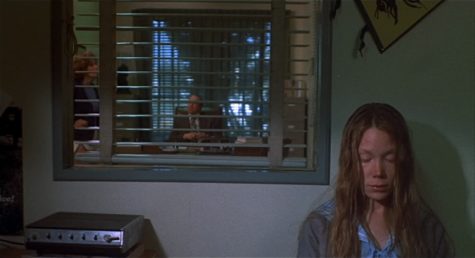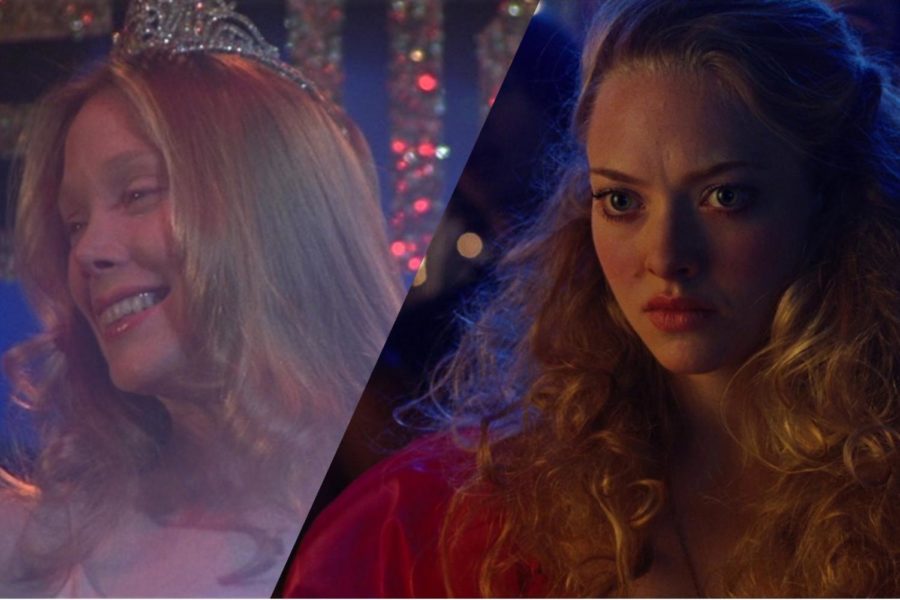Why Female Led Horror Movies Just Make Sense
November 3, 2021
As one of the most popular movie genres, horror has earned a (mostly deserved) reputation of being overtly sexist. From the villains to the final girls, fear in media has often been used as a way to control women in society. By associating certain behaviors with gore and others with happy endings, the media we consume can punish and reward us. Horror movies with female protagonists dispute ancient conceptions about gendered society and the portrayal of gender itself.
Perhaps the emergence of ‘good for her’ cinema can be traced to the 1976 film Carrie. Adapted from Stephen King’s novel of the same name, the titular character of Carrie is tormented relentlessly by her peers and mother. One of the first scenes places the audience in a girls’ locker room. The voyeurism typical of a horror movie directed by a man is not absent; the camera studies the teenage bodies with a passive hunger that seems to be reserved for films of this genre. It is here that Carrie White gets her first period.

A late bloomer, Carrie comes into womanhood later than the other girls, which gives her a prolonged innocence that defines the ‘final girl’ trope. Carrie is horrified; her lack of socialization and fanatically Christian mother has left her ignorant of her own bodily functions. She erupts in distraught cries for help, only to be answered by cheers to “plug it up!” while her female classmates assault her with tampons. It’s a wonder how none of the girls realize the malice in their actions; how they so freely weaponize their experience over a girl who just didn’t know any better. Once at home, Carrie’s mother is eager to inform her of the “sins of women” that caused Eve to be visited with “the curse of blood”. Ignoring Carrie’s desperate retorts that she didn’t sin, her mother continues to insist on the original sin of women. The audience will soon understand that Carrie is at its core, a story about that unrelenting curse of womanhood.
When their gym teacher punishes the other girls for bullying Carrie, two distinct personalities emerge. Sue feels genuine remorse and plans to remedy Carrie’s situation by having her boyfriend take Carrie to prom. Another, Christine, vows to make Carrie pay for her own victimhood. Both of these reactions represent the fate of teenage girls in a patriarchal society — punished for their very existence and rewarded with male attention. Outfitted with stolen makeup samples and a homemade white slip dress, Carrie is showered with flattery from her date and scrutiny from her peers. She hears the dull wave of criticism aimed at her, what was a girl like her doing with a guy like that? Christine is aware too; her plot to make Carrie pay becomes a ploy to humiliate Carrie by making her prom queen. The cruelty of humiliating other women is not understated — it’s not enough for Carrie to be embarrassed, she must also be drenched with pig’s blood. And thus, blood defiles White for the second time.
The audience does not hear Carrie’s cries, just as the rest of the characters didn’t bother to listen. We watch as she breaks down in front of a chorus of uncaring laughter. The pivotal point in Carrie’s sadness is when she understands her full power, when she realizes she does not have to take what she’s dealt. That moment is familiar to many young women, and its portrayal in Carrie has inspired many works that center women’s narratives from Hole’s Live Through This to Olivia Rodrigo’s visual SOUR Prom experience. In a culminating fit of vengeance, Carrie unleashes an anger that teenage girls usually weren’t allowed to express in the media of the time period.
While the magnitude of the girls’ unkindness towards each other can be chalked up to another male director villainizing female socialization and the exaggerated nature of horror, Carrie presents an interesting example of other women’s contributions to misogyny. Refusing to speak in euphemisms and hidden cues, Carrie also dares to confront a culture of period stigma and negative period symbolism. If womanhood is defined by violence, is it not fitting that our story starts and ends in blood?
Another introspection into how women treat each other is the comedy horror Jennifer’s Body. The cult classic stars Megan Fox as the voracious Jennifer Check and Amanda Seyfriend as Anita “Needy” Lesnicki. The two girls are inseparable, and their relationship oscillates between pleasantly romantic and deeply hostile. Like Carrie, Jennifer is plagued by a gender-specific curse. The privileges that have been afforded to Jennifer because of her beauty are not without repercussions. Her allure attracts a lead singer in an indie band that is willing to sacrifice a virgin to the devil in exchange for the promise of fame, justifying her exploitation with her perceived promiscuity. Jokes are scattered throughout the script, but the sad fact is that men often see women as little more than their sexuality and beauty.

Even more important than the way men treat women is the way women treat other women. A few years after Mean Girls, Jennifer’s Body explores the dynamic of toxic female friendship. Jennifer is best described as a deadlier Regina George, her beauty morphing her into something cruel and uncaring. Needy bares her namesake well, her unconscious need for Jennifer’s validation manifests from a crush she’s nursed on Jennifer since childhood. Regardless of the tensions between them, the girls’ love for one another delays the unavoidable catastrophe that will ensue. Jennifer teaches Needy to maintain confidence. And when the town bar burns down, Needy’s first thought is Jennifer’s safety. Even as the demon housed in Jennifer’s soul exaggerates her vanity and malevolence, Needy does whatever she can to restore their friendship. While Needy does have a loving relationship with her boyfriend the entire movie, her interactions with Jennifer illustrate the unconscious connection between friendship and romance that is at the heart of many toxic female codepencies. For reasons unknown to them, Jennifer and Needy need each other — which is a refreshing change from the toxic men and naive girls we so often see in media.
At first glance, the most climactic moment of Jennifer’s Body is centered around Needy’s boyfriend — the last boy Jennifer claws into. It is important to note that this scene actually depicted Needy confronting the toxicity of her relationship with Jennifer. No woman, even one as beautiful as Jennifer, will ever feel “enough,” under the patriarchy as it becomes obvious that her self-absorption conceals her self-hate. She could have anybody she wants,” but she seeks impossible validation from the only person she can’t have: Needy’s boyfriend. It’s at this point that Needy fully realizes that Jennifer isn’t good for her; that the romantic “sandbox love” of their youth had become an unhealthy obsession.
It’s common to see a woman breaking free of a man’s grasp, but Needy finally seeing Jennifer for who she is both maintains the intensity of relationships with other women and contends the misconception that women can’t be dangerous.
Carrie and Jennifer’s Body spotlight the role female friendship has in women’s development. Both movies argue that monsters can look just like us.
